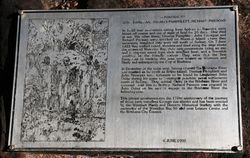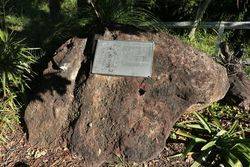
Home » Themes » People » Exploration
John Finnegan, Thomas Pamphlett & Richard ParsonsPrint Page 
The plaque commemorates John Finnegan, Thomas Pamphlett and Richard Parsons and their journey to Moreton Bay in 1823, and was unveiled on the 170th anniversary of their journey.
Pamphlett and fellow "ticket of leave" convicts Richard Parsons and John Thompson, along with full convict John Finnegan, were hired by settler William Cox to fetch cedar from the Illawarra District, 80 kilometres south of Sydney, New South Wales.
The four set sail on 21st March 1823 in a vessel that was 29 feet long and with a beam of 10 feet. They carried a large quantity of pork and flour, as well as five gallons of rum to buy cedar from the timber cutters, plus four gallons of water. They were within sight of Illawarra when a strong gale blew them away from the coast. It was five days before they could use any sail, by which time they had drunk the water and the rum, and they men were hopelessly lost.
The group thought they had drifted south and so headed northwest to try to get back to Illawarra and Sydney. Pamphlett spotted land on their twenty-second day at sea. Before they could land, Thompson succumbed to the lack of fresh water and the elements, and collapsed and died. They kept his body on board, thinking they would be able to land and bury him, but they couldn’t find a spot free of wild surf so buried him at sea after two days. Pamphlett, Finnegan and Parsons finally landed on Moreton Island.
Thinking Sydney was to the north, they set off along the beach in this direction with two sacks of flour and a few other items. They lived for periods with several Aboriginal tribes who thought they were the ghosts of their ancestors due to their pale skin colour. Eventually, the aboriginals took the three men to Stradbroke Island. It was here, that the intrepid crew built their own canoe and eventually made it to the mainland.
It is thought, they landed somewhere in the area now known as Cleveland. Still thinking they were south of Sydney, the three men continued their journey northwards along the coast, following native paths. It is thought they may have travelled along what is now Tingal Road. From the top of Lytton Hill, they were the first Europeans that we are aware of, to sight the mouth of a river, later known as the Brisbane River which flowed into Moreton Bay.
On 29 November 1823, Pamphlett and some Aborigines were on the beach at Bribie Island when he saw a cutter in the bay. It was explorer John Oxley who had been searching up and down the coast for a new convict settlement. Only then did Pamphlett learn that Sydney was 800 kilometres to the south rather than to the north. The next day, Finnegan showed Oxley the Brisbane River. Oxley took Pamphlett and Finnegan back to Sydney.
A year and a half later Pamphlett committed another crime, for which he was sentenced to seven years’ transportation to the new Moreton Bay penal colony. The colony had been set up after a favourable report on the area by Oxley, thanks to Pamphlett and Finnegan.
.
Location
| Address: | Tingal Road, Wynnum, 4178 |
|---|---|
| State: | QLD |
| Area: | AUS |
| GPS Coordinates: | Lat: -27.442971 Long: 153.169064 Note: GPS Coordinates are approximate. |
Details
| Monument Type: | Plaque |
|---|---|
| Monument Theme: | People |
| Sub-Theme: | Exploration |
| Approx. Event Start Date: | 1823 |
| Approx. Event End Date: | 1993 |
Dedication
| Actual Monument Dedication Date: | Sunday 6th June, 1993 |
|---|
Memorial to John Finnegan, Thomas Pamphlett, Richard Parsons
In 1823, four ex-convicts sailing from Sydney to Illawarra were blown off course and out of sight of land for 25 days. One died at sea. The other three, Thomas Pamphlett , John Finnegan and Richard Parsons were wrecked on Moreton Island where they incorrectly imagined they were still south of Sydney. On 7 June 1823 they walked naked, shoeless and tired along the ridge above the shores of Waterloo Bay, their only possessions being an axe and a billy-can saved from the wrecked boat, and a fire-stick provided by the friendly natives. They were thus the first Europeans to traverse this area now known as Wynnum and Manly and susequently the City of Brisbane.
In December of the same year, having crossed the Brisbane River and reached as far north as Bribie Islamd,Thomas Pamphlett and John Finnegan were fortunate to be found by Lieutenant John Oxley during his quest to investigate potential penal settlements north of Sydney. They guided Oxley to the Brisbane River and returned with him to Sydney. Richard Parson was rescued by John Oxley on his second voyage to the Brisbane River the following year.
This plaque commemorates the 170th anniversary of the journey of those early travellers through this district and has been erected by the Wynnum Manly and Districts Historical Society with the assistance of Waterloo Bay 50 and over Leisure Centre and the Brisbane City Council.
6 June 1993





